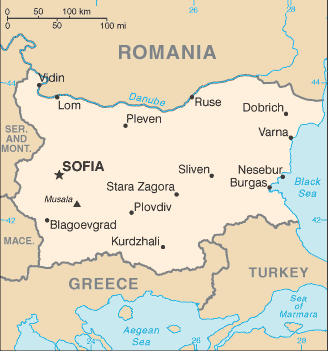Map:

Overview:
The Bulgars, a Central Asian Turkic tribe, merged with the local Slavic inhabitants in the late 7th century to form the first Bulgarian state. In succeeding centuries, Bulgaria struggled with the Byzantine Empire to assert its place in the Balkans, but by the end of the 14th century the country was overrun by the Ottoman Turks. Northern Bulgaria attained autonomy in 1878 and all of Bulgaria became independent in 1908. Having fought on the losing side in both World Wars, Bulgaria fell within the Soviet sphere of influence and became a People's Republic in 1946. Communist domination ended in 1990, when Bulgaria held its first multiparty election since World War II and began the contentious process of moving toward political democracy and a market economy while combating inflation, unemployment, corruption, and crime. Today, reforms and democratization keep Bulgaria on a path toward eventual integration into the EU. The country joined NATO in 2004.
The People:
Population: 7,450,349 (July 2005 est.)
Age structure:
0-14 years: 14.1% (male 539,005/female 512,762)
15-64 years: 68.7% (male 2,516,368/female 2,599,524)
65 years and over: 17.2% (male 531,008/female 751,682) (2005 est.)
Religions:
Bulgarian Orthodox 82.6%, Muslim 12.2%, other Christian 1.2%, other 4% (2001 census)
Government Type:
parliamentary democracy
Leader(s) to pray for:
chief of state: President Georgi PURVANOV (since 22 January 2002); Vice President Angel MARIN (since 22 January 2002)
head of government: Chairman of the Council of Ministers (Prime Minister) Simeon SAXE-COBURG-GOTHA (since 24 July 2001); Deputy Prime Ministers Nikolay VASILEV (since 24 July 2001), Lidiya SHULEVA (since 24 July 2001), and Plamen PANAYOTOV (since 17 July 2003)
Source: The World Factbook
View All Countries